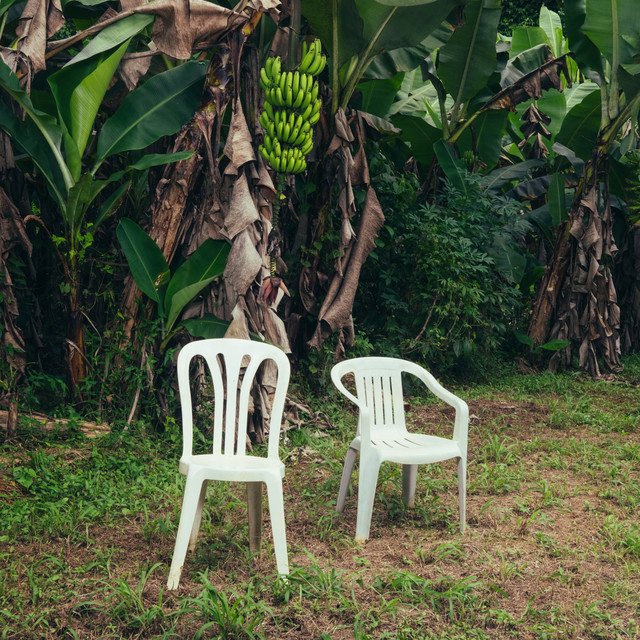We should all take more photos.
In an album that spans genres and generations, based in the sound and culture of Puerto Rico, Bad Bunny tells us to live in the moment and enjoy the present.
Bad Bunny’s latest album, DeBÍ TiRAR MáS FOToS, was highly anticipated by many, including myself. I love Un Verano Sin Ti, an album that blends genres, cultures, and is all around a fantastic experience. The album that followed, nadie sabe lo que va pasar mañana, was slightly lacking in comparison, though it wasn’t bad by any means—there are plenty of tracks I liked and still listen to. So, when Bad Bunny started teasing this new project and especially when I heard that second single, “PIToRRO DE COCO,” I knew what was coming was going to be another cultural magnum opus that encapsulated the heart and soul of Latin music.
Sonically, this album encapsulates Puerto Rico. Reggaetón, plena, musica urbana, salsa, and more—this album transports its listener to the streets of PR, past and present, by emulating the sounds that come straight from the heart of the island. The variety of genres, musical instruments, and singing styles means that the album is never boring, which can be a common complaint with reggaetoneros. Bad Bunny reinvents classic genres while revitalizing lost ones, making DTMF an engaging and immersive listening experience.
The first track, “NUEVAYoL,” is like the blurb on the back of a book jacket. It’s everything the album stands for wrapped up into one song. The track starts with a snippet of “Un Verano en Nueva York,” a classic salsa hit by El Gran Combo from 1975 that older generations grew up listening to. The song then fuses into dembow, a Dominican genre of music that’s very beat-heavy and follows more of a rap style. Dembow is more modern and is currently very popular with the younger crowd. “NUEVAYoL” isn’t just a blend of genres, it’s a blend of generations. Bad Bunny has a reputation among the older crowd for being vulgar and abrasive; oftentimes, they dismiss his talent. By sampling El Gran Combo, Bad Bunny is inviting our grandparents to try and appreciate the album for what it is: a love letter to Puerto Ricans. And that means Puerto Ricans everywhere, including the ones not on the island. New York has an important place in Puerto Rico’s history: it is home to many in the diaspora and has been integral in shaping the Puerto Rican music scene. The chorus of “NUEVAYoL” uses lyrics from the El Gran Combo sample, “Si te quieres divertir/Con encanto y con primor/Solo tienes que vivir/Un Verano en Nueva York” (If you wanna have fun/With delight and with charm/You only have to live/A summer in New York). Bad Bunny’s rendition is full of New York references from various eras, again bridging the gap between generations. References like Willie Colón, a New York-born salsa artist; Juan Soto, a Dominican baseball player who used to play for the Yankees (and now plays for the Mets); and Toñita’s, the oldest Latino club in Brooklyn. Opening the album with this song ensures that diasporic Puerto Ricans aren’t left out of an album that celebrates their heritage. Across generations and continents, Puerto Ricans are connected to this album.
The romance of DTMF is also certainly of the highest quality, with “BAILE INOLVIDABLE” really setting the album apart. The song opens up with this sexy, futuristic synth that almost transports you to another realm. Against this backdrop, Bad Bunny deeply and severely yearns for his ex-girlfriend in the most romantic lyrics ever. Quite taboo to describe pining for your ex as romantic, I know, but there’s no other way to describe these words:
Pensaba que contigo iba a envejecer
En otra vida, en otro mundo podrá ser
En esta solo queda irme un día
Y solamente verte en el atardecer
Si me ven solo y triste, no me hablen
Si me ven solo y triste, soy culpable
La vida es una fiesta que un día termina
Y fuiste tú mi baile inolvidable
I thought I'd grow old with you
In another life, in another world, it could be
In this one, all that's left is for me to leave one day
And only see you in the sunset
If you see me alone and sad, don't talk to me
If you see me alone and sad, it's my fault
Life is a party that one day ends
And you were my unforgettable dance
The song then transforms into a classic salsa: the güiro, congas, cowbells, horns, and background singers flood the production. It sounds just like the music we hear at family gatherings and invites everyone to just get up and dance. This is the soul and essence of Puerto Rican music and sound, and it underscores Bad Bunny’s appreciation of the musicians that came before him. Lyrically, the track remains just so tragically beautiful. The refrain says, “No, no te puedo olvidar/No, no te puedo borrar/Tú me enseñaste a querer/Me enseñaste a bailar” (No, I can't forget you/No, I can't erase you/You taught me how to love/You taught me how to dance). This is more than Bad Bunny just longing for the love of his life, this is a call back to “Enséñame a Bailar” from UVST where he asks a girl to teach him how to dance until the sun comes up. Now, she is as unforgettable as the night he met her. Salsa is often known to have romantic lyrics, and Bad Bunny definitely satisfied that component.
Bad Bunny has never shied away from political messaging in his music, but he ups the ante on DTMF. “LO QUE LE PASÓ A HAWAii” is a song that highlights the similarities between Hawaii and Puerto Rico, particularly in regards to colonization. In the track, Bad Bunny speaks to a personified Puerto Rico as if she were a beautiful woman. He says, “Que no quiero que hagan contigo lo que le pasó a Hawái” (“I don’t want them to do to you what they did to Hawaii”). What did they do to Hawaii? They gentrified it. Now, Bad Bunny is not against tourism, in fact his upcoming residency in PR shows he encourages it, as you’ll have to travel to PR for the only chance to hear him sing DTMF live. Bad Bunny is, however, against the destruction of his culture caused by more and more non-Puerto Ricans moving into the island. Both Puerto Rico and Hawaii have the misfortune of being a part of the United States, meaning Americans from the continental U.S. have easier accessibility to the islands since they don’t need special documentation to move there. When more people move in, the lands and the people suffer, as we have seen with Hawaii. Bad Bunny says “Quieren quitarme el río y también la playa/Quieren el barrio mío y que abuelita se vaya” (They want to take my river and the beach too/They want my neighborhood and grandma to leave). The “they” in these lyrics refers to the corporations, government officials, and wealthy Americans moving to Puerto Rico. These people are ruining the nature of the island and simultaneously removing the people it belongs to. Later in the song, Bad Bunny switches the lyric “abuelita” (grandma) to “tus hijos” (your children), again bringing in an intergenerational element. The song starts off sort of stripped, but as it progresses, more instruments are added, including a beautiful and haunting melody with a guitar. The growing intensity and inclusion of more sounds highlights the desperation and urgency of the situation. The heart of Puerto Rico will be lost if her people are continually pushed out by gringos. The political messaging of this album is purposeful, releasing just a month before the 2024 presidential election. And, especially in today’s climate, PR is often forgotten or seen as unimportant. Bad Bunny speaking on these topics in a heavily commercialized album will do a lot in spreading awareness of the situation.
The last song I’ll get into is arguably the most important one on the whole record. “DtMF,” the title track of this project, is incredibly sweet. It is a song about appreciating your loved ones while they’re with you. Bad Bunny sings, “Debí tirar más fotos de cuando te tuve/Debí darte más beso' y abrazo' las vece' que pude” (I should've taken more pictures when I had you/I should've given you more kisses and hugs whenever I could). DTMF tells stories through heartbreak, friendship, culture, and family, which all boil down to the core message: we should all take the time to live in the present. The genre of the song is plena, an Afro-Puerto Rican style of music that is only really known in the island, until now at least. The track is filled with drums which keep it very light and upbeat—a song that makes you just want to dance around with your friends. This track sparked an incredibly sweet trend on TikTok of people sharing their loved ones who have passed, with most of the videos coming Latinos sharing photos of their grandparents in their homelands. A lot of these photos included white plastic chairs, just like the ones on the album cover. That is the heart of this album. Bad Bunny wanted to make something that people could understand, that they could see themselves and their history in. He posted a video crying to the trend, which sparked even more videos that made even more people cry. It was an incredible moment within the Latino community of people connecting with strangers and encouraging each other to take more pictures with the ones they loved. Bad Bunny’s fans also cried while watching the short film that accompanied the song, which depicts an elderly man reminiscing on his life and navigating a gentrified Puerto Rico. The video is undoubtedly well-aligned with the political messaging we see in other parts of the album as well. “DtMF” closes out with a stripped instrumental of just drums and background singers shouting into the mic, like a bunch of friends having fun in the booth. Once again, Bad Bunny is emphasizing the joy of spending time with the people in your life and how simple it can all be.
Here’s some tracks that I didn’t dissect but certainly deserve some shoutouts: “EoO” and “VeLDÁ,” classic reggaeton tracks that take me back to the 2000s in the back of my mom’s car; “CAFé CON RON,” which has this really cool breakdown in the middle of the track and features a band trying to revitalize the plena genre, and “PIToRRO DE COCO,” the single that piqued my interest and is one of the best sounding tracks on the album.
DeBÍ TiRAR MáS FOToS blew all of my expectations out of the water. It’s a project that gives me everything I want in an album and then some. It’s political, romantic, melancholic, joyful, celebratory, self-reflective, and everything in between. And, most importantly, it’s an album Bad Bunny dedicated to his people. You can hear the love and appreciation Bad Bunny has for his island and people in every song, which makes this album all the better to listen to. DTMF is a masterpiece at every turn. Although there’s been some stiff competition and the album came out just five days into 2025, I think DeBÍ TiRAR MáS FOToS deserves to be Album of the Year, and I hope you’ll all give it a listen.
edited by Samuel Espinal Jr.
album artwork believed to belong to either the publisher of the work or the artist.

